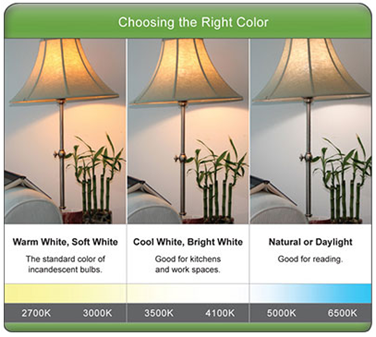Lighting your home or business comprises around 15% of your overall energy bills. On average, $200 is spent each year to light your home. These numbers may not seem like a lot, but consider this: you can cut that expense at least half with little cost and almost no effort on your part. By simply replacing incandescent light bulbs with CFLs you can significantly lower your home's energy costs. Want more savings? Install dimmers on your switches to make those new light bulbs last even longer and extend your savings. If you sometimes forget to turn off the lights, add motion sensors or timers to your indoor and outdoor lighting to make sure you're only using energy and spending your money when and where you need it. Making a few simple, cost-effective changes to the lighting you already have can help you on your way to illuminating your life with savings.
Ready to make the switch? EnergyEarth is here to help make it easy for you. The light bulb equivalent chart below will help you understand which CFL bulb is comparable to your current incandescent bulb. Simply take your current incandescent watts and select the corresponding CFL bulb equivalent. Pay close attention to Lumens, since this number indicates the brightness, or light output, of the bulb. To save the most energy, choose the bulb with the lowest wattage suitable for its usage.
| Electrical Power Consumption in Watts | Minimum Light Output in Lumens | |
|---|---|---|
| Incandescent | CFL | |
| 25 | 4 - 9 | 250 |
| 40 | 9 - 13 | 450 |
| 60 | 13 - 15 | 800 |
| 75 | 18 - 25 | 1,100 |
| 100 | 23 - 30 | 1,600 |
| 125 | 28 - 40 | 2,000 |
| 150 | 30 - 52 | 2,600 |
Choosing the right color:
Light color, or color temperature, is described using the Kelvin scale(K). CFLs are available in warm colors to match the yellowish light of incandescent bulbs, but you can also choose cooler colors with whiter or bluer light. A lower Kelvin number mean the light appears more yellow; higher Kelvin numbers mean the light is whiter or bluer.
CFLs are made to match the color of incandescent bulbs at 2700-3000K. If you prefer a whiter light, look for bulbs marked 3500-4100K. For bluer white light, look for bulbs marked 5000-6500K.

CFLs
CFLs come in a wide variety of sizes and fittings. The most common are:
- Spiral: Arguably the most versatile, these replace incandescent bulbs in ceiling fixtures and fans, table and floor lamps, wall sconces and covered outdoor fixtures.
- Capsule/A-shape: Just as versatile as spiral bulbs, these maintain the same looks as incandescent bulbs and are often used in fixtures where the bulb is visible.
- Reflector: As these provide directional lighting, they are ideal for ceiling fans, recessed cans and tracking lighting.
- Globe: Just like the globes you already have, but more efficient. For use in bathroom vanities, pendant fixtures and other areas where the bulb is visible.
- Candle/Torpedo: Also just as versatile as spiral bulbs, these are perfect for wall sconces, some ceiling fans and fixtures and covered outdoor fixtures where candle lights are desired.
- Tube: Available in twin, triple and quad biax, tube lamps are comprised of parallel tubes that vary in length and light output depending on the number of tubes.
- Outdoor: Wet-rated, meaning they can be used outside in exposed fixtures without damage to the bulb or fixture. Most are reflector shaped, making them perfect for outdoor flood lights.
- 3-Way: Just like incandescent 3-way bulbs, these can switch between 3 light levels, making them ideal for many table and floor lamps. Only use CFLs that are specifically designated for use in 3-way sockets.
- Dimmable: Made especially for use in dimmer switches for the most efficiency and savings. Note: It is not recommended to use a regular CFL with a dimmer switch as it will reduce their lifespan.
CFLs use a completely different technology than traditional incandescent bulbs. Instead of an electric current running through a metal wire, an electric current is transmitted through an internal ballast and into a tube containing argon and trace amounts of mercury. These elements then emit UV rays, which energize the fluorescent (phosphor) coating on the inside of the tube, releasing visible light. The initial illumination uses slightly more energy than an incandescent bulb so a slight flicker can sometimes be seen as the bulb warms up; however, the energy needed for continued operation is significantly lower.
Safe disposal of CFLs is actually quite easy. CFLs do contain trace amounts of Mercury (less than 100th of the amount in a mercury thermometer), so they should not be thrown in the trash where they can be broken. Instead, many areas provide curbside collection of CFLs or central recycling locations. If this is not available in your area, EnergyEarth offers a CFL recycling box with mail-back service on our website.

